| |
Our Allies, the French It is easy to forget that the
French and US military closely cooperated in matters of western
European security, even though France had formally departed NATO
in 1966. The western region of Germany and the French - German
border area along the Rhine River were the main areas of concern
of the FFA, the acronym of the French Army deployed to Germany.
Major bases were in the cities of Landau, Kaiserslautern and
Baden - Baden and while joint maneuver participation was
limited, the French did take an interest in NATO strategic
planning.
With the end of the Cold War, there has been significant
disagreement between France and the US over Middle East policy
from Israel to Iraq. To understand this, we should recall the
long French tradition of a separate foreign policy based solely
on French goals, that France has the largest Moslem minority of
any European nation and that they fought and lost a bitter war
in Algeria in the late 1950s that almost led to the collapse of
the government in Paris. To their credit, the French have troops
deployed in the Kosavo - former Yugoslavia region as part of
that peace keeping effort and they have actively tried to
intervene in the seemingly endless fighting in sub - Sahara
continental Africa, an area that the US has decided is not of
significant strategic interest to merit action beyond debate and
diplomatic discussion.
For the troopers of the Eaglehorse, contact with the French
military was rare but not unheard of. Follow this web link to
read a Stars and Stripes article detailing French military
augmentation to the 11th ACR surveillance mission along the
Czech border in the early 1960s.
http://usarmygermany.com/Units/ArmoredCav/USAREUR_11thACR.htm
In the mid 1970s, select troopers of the squadron had the
chance to attend one of the French Army Commando Schools in
Germany.
French Commando School Number 4 and the Men of the Eaglehorse
Major M.W. McGehee US Army (Ret)
Fox Troop, 2/11th ACR, was the first unit in the
Blackhorse to send a platoon to French Commando School in the
late spring of 1976. I was about to finish eighteen months as a
platoon leader and was ready for another job. Then came an
opportunity that threw SSG Hale and me together for an
unforgettable three weeks. CPT Clint Ancker, F Troop commander,
and 1LT Chip Raymond in the S-3 worked together to find some
adventure training that we could participate in. So, after lots
of phone calls and no doubt favors called in, we were approved
to go. I was selected to lead the first platoon from Troop F. We
were then to be followed by a Troop E platoon. The school was
located in the Black Forest area of Breisach, Germany.
| |
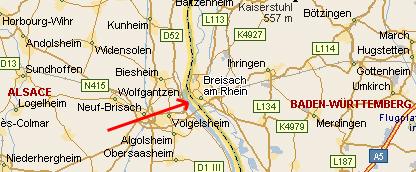 |
|
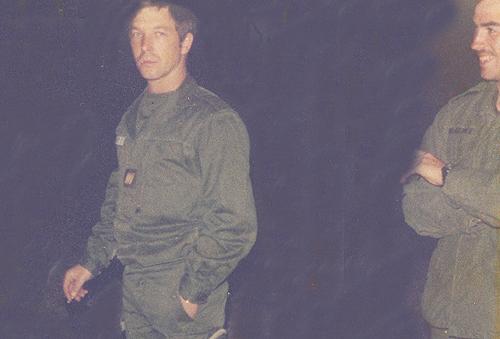 |
|
| |
The town of Breisach, at red arrow, about as far southwest as you
can go in Germany. Just over the river was France. |
|
Here we are at the Commando School, French Instructor Adjutant Chief
Guilbod, "Tac Tac , and 2 Lt McGehee, June 1976. |
|
SSG Hale and I hit the road in his German Ford to visit the
future training site, over ½ way across Germany on the French
border. One of our hosts treated us to a home cooked French
dinner and showed us his photo album from his days in Viet Nam.
Before we left we had traded berets, uniform jackets, and jump
wings. After hearing about the marches we were expected to make,
we could see we had some training to do back home. We did our
best to get the troopers ready physically with long road marches
carrying our M16 rifles and borrowed rucksacks from our West
German border partners, the Bundesgrenschutz, the Federal Border
Guards. We suspected we were in for a hard time since our
troopers were more in to riding than walking but we made the
most of our training time.
Our support group consisted of two 5-ton trucks from the
support platoon, our medic, and an arms room specialist. Part of
the conditions for our training required us to compensate the
French for living in their barracks and for the meals we
received. I drew $1,800 from the finance office in Schweinfurt
and got that converted in to French francs. When we arrived at
the school I secured the money, sealed in an envelope, in the
school’s safe. We only knew that it cost .80 francs per trooper,
per day to live in their barracks. We also brought our own
cleaning supplies and TP since the conditions weren’t up to
Eagle Horse standards! The NCOs and I were required to eat in
their NCO/Officer "clubs" while the troopers ate with the French
junior enlisted in their mess hall. We had coffee and bread for
breakfast. The coffee was served out of a big pot. Instead of
cups, we had clear glass dessert bowls that we had to dip into
the big pot. We always had butter for the bread but we didn’t
always have jelly. We used our pocket knives to slice the long
loafs of bread that a French private delivered to the little
club. He would carry three loafs under each sweat dampened
armpit so his hands were free to carry the big pot of coffee.
Yep, we were tough! Lunch and dinner with the sergeants in the
larger club was much better than breakfast. We had waiters that
brought the food to the table and it was pretty good. Once or
twice we ordered a bottle of red wine to top off a nice diner
and now and then we had a round of espresso coffee after lunch.
We had no idea what this was going to cost, but thankfully it
all worked out all right. We tried to hold the line. Water was
served in a pitcher with the word "Richard" on it so we all had
fun asking for someone to "please pass the Richard".
A typical day started with a fast run at 0600 followed by the
flag raising ceremony. We were one of three platoons in
training. The other platoons consisted of a group of French
engineers and a platoon of recent inductees. As I recall, the
French had a draft and a one-year enlistment. They run all their
troops through commando training. After the run we’d cut some
bread and dip some coffee before the main training began. I’ve
often described the training as preparation for a circus that
blows thinks up. There was lots of jumping, climbing, and poll
vaulting and working with rope. They taught us how to climb up a
chimney from the inside and how to climb fences with triple
strand barbed wire. One afternoon we had 23 general officers
drop in to watch us vaulting over a water obstacle. We would
have made pretty good second story men. Our lunch came after the
morning activities.
| |
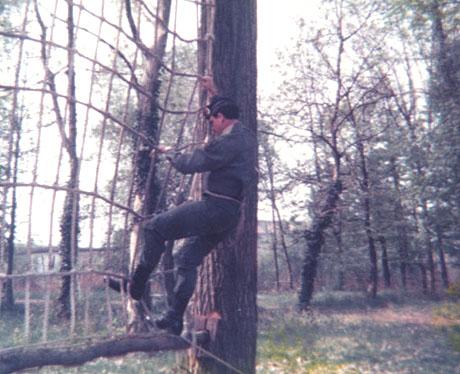 |
|
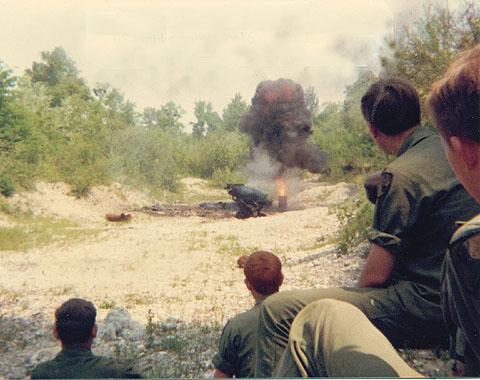 |
|
| |
SSG Hale, the senior NCO in our party, works the rope ladder. |
|
Field expedient demolition class at the Commando School. |
|
The French don’t like to rush a good meal, so we usually had
about an hour to eat lunch. They gave us a survival ration early
on and told us to carry it until they told us to take it out.
Another time during the last days there we were issued a three
course C-ration with cognac. One day in the second week we were
learning small boat handling on a nearby river or lake. Just
before lunch, the cadre NCOs invited Hale and me to eat some
fresh road killed rabbit with them while the troopers were told
to pull that survival ration and chow down. I wasn’t sure if I
was getting the better meal or not, but SSG Hale thought we had
better join the cadre. That was the best rabbit, cooked with
orange slices and smothered in white wine sauce. After trying
the before dinner white wine and during dinner red wine, the
dessert consisting of sliced fruit floating in cognac was
gleefully consumed. SSG Hale and I had spent nearly two hours
with our hosts and were feeling right well!
Dinner was always at the large club unless we were in the
field training overnight. Once we had to navigate with 1948
vintage maps and our compasses to find our C-ration dinner.
Another time we were learning survival cooking. They had us
ground all of our clothing except underwear and our berets and
don some old French khaki uniforms to simulate POW wear. It was
ok to keep our pocket knives. We were simulating that we had
escaped and were met by some friendly locals (some of the cadre)
who supplied us live chickens and helped us fish for our supper.
We had an interesting meal of eel and chicken and a fish or two
and had to erase all signs of meal preparations before the
inspectors arrived at first light. Another time we learned you
could make biscuits with flour and beer, but we passed around
the liter bottle instead like any normal soldiers would do.
During survival training, we had a class on mushrooms where
we pondered over which to eat, and which to feed to your
mother-in-law. The problem was the instructor didn’t speak
English or German. He did speak Spanish and we had two NCOs from
Puerto Rico. I remember cautioning the two of them "you guys
better not louse this up". It was lucky for us that we didn’t
have to eat any. More really great training was had in
demolitions using blasting caps, C-4, time fuse, and demo cord.
We blew a steel pot 100 feet in the air with just a blasting cap
to show how strong they were alone. Using a wine bottle (these
weren’t in short supply), C-4, time fuse with cap and igniter,
we made shaped charges that burned through steel I-beams. We
tied a grass string soaked in kerosene around the bottle and lit
it. Once hot we dropped it in water to get it to break clean.
Then we tied three sticks to the top half of the bottle with the
neck pointing down and filled the void with C-4 with a blasting
cap, a time fuse, and an igniter. The hot gases would bore a
nice hole through steel. We were told that if you sat one of
these babies on the back deck of a tank you’d have at least a
mobility kill to your credit.
It wasn’t all work as you might expect. We trained on
Saturday mornings but were free to venture down to the small
town of Breisach, Germany. I learned that I was no boxer on that
first Saturday when the French Sergeant Major teamed me against
the French cadet assigned to help us communicate. He had arms
like yard sticks and was a good foot taller than me. Once that
humiliation ended, I went to Breisach and had a cool mug of beer
in the local Gasthaus. Just above the bar hung a liter mug with
the German WW II paratrooper badge attached. I asked the fellow
behind the bar, in German, whom that belonged to and he proudly
pointed to himself. After a minute or two of soldierly
discussion, he invited me to see his Luftwaffe dagger and a
picture of him as a young LT about to exit a perfectly good
Junkers 52 aircraft. Another time SSG Hale and I were invited to
go with the French NCO cadre to eat at a restaurant in France,
just across the river dividing the two countries. I figured they
had run over a cow or something of that order, but this meal was
store bought. The Sergeant Major drove us in one of those Citron
swept-back sedans. He hardly slowed down at the customs checks
and we didn’t even have to show our Ids once they spotted him.
The French and Germans just waved him through. I don’t remember
much about the meal, but I do know we came back after midnight
that Friday and re-opened the little club where we had our
breakfasts. We heard war stories until after 0200. That wouldn’t
have been so bad, but they got us up at 0430 to go mountain
climbing in France that same Saturday morning.
No discussion of the time we spent during that three weeks is
complete without telling about the old fortress in France that
we trained in and later stormed after a long run. It had a moat
and was built with many angles so that one wall could provide
avenues of fire for defense of the adjacent wall. I think these
are called "Vauban" style fortresses. We had two drills of
courage that we could only do at the fortress. One was jumping
from the wall straight out about three or four feet to make
contact and then slide down a wooden pole. It was slick as a
cat’s gut from use and didn’t have any splinters. The method was
to extend the top of a boot to sort of break the force of your
horizontal contact, and then slide down the pole. The next part
of this two-part drill was to jump again at another pole; which
was twice as far from the wall. Both the pole jumps were easy
compared to the second big drill, jumping from the top of the
wall to the ground below, hands first in to pea gravel. We
jumped the poles several times but only once did we have to jump
to the ground. The cadet and I had to just lean over to where we
lost our balance and pointed our hands at the gravel 10-12 feet
below. Surprisingly, no one got hurt. In fact the only casualty
we had was the medic who had a knee go out on him during one of
the many 8 km runs. We survived the four or five commando
marches; grueling eight km group runs with pack and rifle with
one-hour time limits. Our final "march commando" was part
of our attack on that old walled fortress in France. But before
I get in to that, I must explain why the necessity for running 8
km as a group in an hour or less. The French told us it is very
simple. If you’re behind enemy line doing what commandos do,
i.e. blowing stuff up, then you’d better get 8 km or more away
in an hour after they know you’re there or you stand a good
chance of getting surrounded and captured. This was our night to
prove that. We arrived after dark and had partisans assist in
tossing us ropes to scale walls to affect entry so we could
destroy an ammo dump inside the fort. We watched the guards and
timed their movements so we could dash hither and yonder
undetected. We also had to "kill" as many of the guards as
possible by catching them as they changed shifts. I had taken an
unauthorized artillery simulator with me and really caused
surprise when I set it off as we sprayed them with M16 blanks.
Looking back now, I recall the fine French SSG who was our
primary trainer. R.Guilbod, who we respectfully called "Tac Tac",
was a proud paratrooper with a great way about him. He was with
us night and day for three weeks. For some reason, the French
liked to shout, "TacTac, La Peche" which may be spelled wrong.
It means the "peach" as best as we could tell. That is how
Adjutant Chief R. Guilbod got the nickname. I bought a Zippo for
him after we got back and had that saying and his name engraved
on it in downtown BK. I hope he got it.
We had two visitors come all the way from BK to check on our
progress. CPT Ancker made the first OH-58 trip with hot refuel
along the way. I think they must have flown three hours or so.
The second visit was the morning of graduation when Major Frank
Kolezar landed in an open field near Muhlfeld just about the
time we got our badges.
Our graduation exercise was a two or three day, 60 km walk
through the Black Forest with the French cadre trying to get us.
I learned several important lessons during that exercise. First,
I found out why they call it the Black Forest. It was so dark we
had to grab the rucksack of the man ahead of us to follow along
without getting lost. We entered by helicopter and moved as a
company, platoons in column. We got to a spot in the forest
where we reached a bad cliff that dropped a long way to the road
we needed to cross down below. The French captain commanding our
company told me that we weren’t going to descend the cliff in
the dark, we turned around and found a safer route. I’ve always
assumed this was the cliff where LT Charlie White from E Troop
got hurt the following month leading a second group of
Eaglehorse troopers through the training.
| |
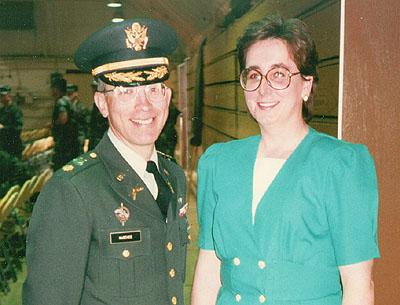 |
|
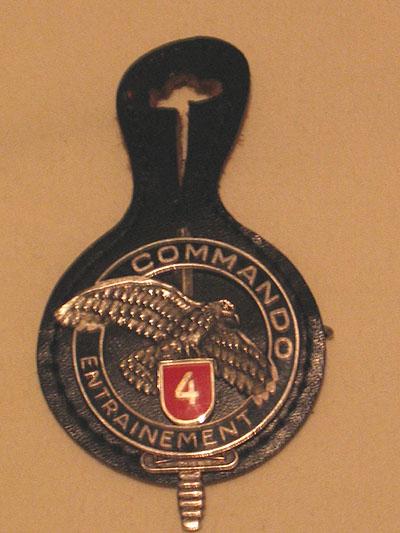 |
|
| |
My retirement in 1994, the Commando Badge still proudly worn just
above the name plate. I am standing with my wife. |
|
Here is the actual badge I was awarded in 1976 after the all night
march. A meaningful souvenir from early in my career. |
|
Second, I learned that when you make a map reading error
while walking up and down lots of hills and have to retrace your
steps, the folks you’re leading tend to get upset with you.
Lucky for me, I had SSG. Hale along to keep me straight, most of
the time. I also learned that if you allow everyone in the
platoon to sit down to rest after little sleep and lots of
walking, everyone goes to sleep. That last day we walked about
40 km in about 24 hours while being chased and shot at by the
French. Anyone who was there will remember SGT Zamora and how he
found his way to the graduation site every time we were hit by a
French attack and got scattered. They had to keep bringing him
back to us. I think that he took a taxi one of those times! I
guess my strongest memory was learning what a fine soldier and
human being SSG Raymond Hale really was.
Our platoon arrived at an open field near Muhlfeld about 0330
on graduation day. The French had set up tables and had a fire
burning. Since we had more than two hours before graduation, "we
slept on our arms" until awakened by the noise from the other
two platoons arriving. Have you ever sipped bubbly at 0600? We
did. No, there were no smacks on the cheeks from the French
Colonel. We got are badges and were ready to go home to BK. We
sent the troopers home by bus and Hale and I went back to the
school to pay the bills. I had about $30 in francs left over!
Once that was done S.G. Hale and I tried to drive home but had
to stop for a good nap first. There to greet me when I got back
was CPT Bob Baize, our XO. He told me that I was to be the new
Border Officer.
In 1986, just prior to my leaving VII Corps G3 Operations and
before becoming operations officer of 2/37th Armor, 1st
ID (Fwd), I drove the family to Breisach. As we passed the quiet
little school I showed my wife and sons where I spent three
great weeks, my last weeks as a "butter bar LT". It hadn’t
changed much in the ten years since I was last there. I want to
send special thanks to Clint Ancker, Chip Raymond and pay
special tribute to the late Raymond Hale for making these
memorable experiences possible.
Current Status of Breisacher Kaserne
We asked the town of Breisach about the current status of the
French barracks and the city museum sent a prompt reply. The
French departed in 1997 and both the older Kaserne, dating from
1900 and the "newer" French additions, 1950, were remodeled and
converted to civilian use. Among the new activities in the
modernized spaces, a school, youth center, apartments,
restaurants and offices for local social service providers.
|
|